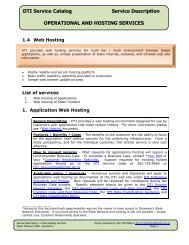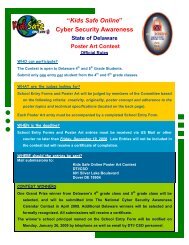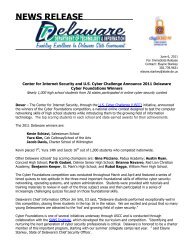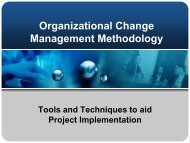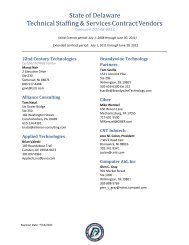Organizational Project Management Maturity Model (OPM3)
Organizational Project Management Maturity Model (OPM3)
Organizational Project Management Maturity Model (OPM3)
Create successful ePaper yourself
Turn your PDF publications into a flip-book with our unique Google optimized e-Paper software.
Quarter 3<br />
September 2005<br />
Vision: Provide consistent quality leadership in project management using industry best practices.<br />
Enhance the acceptance of cultural and technological change to maximize the benefits of major projects.<br />
<strong>Organizational</strong> <strong>Project</strong> <strong>Management</strong> <strong>Maturity</strong> <strong>Model</strong> (<strong>OPM3</strong>)<br />
Highlights • • • •<br />
More about <strong>OPM3</strong> …<br />
from your CPO<br />
<strong>Project</strong> <strong>Management</strong><br />
eGovernment Program<br />
Change <strong>Management</strong><br />
ERP Service Delivery<br />
<strong>Project</strong>s<br />
In our June 2005 newsletter, I stated<br />
that we had signed a contract with<br />
<strong>Project</strong> Assistants, Inc. to conduct an<br />
assessment of the overall level of<br />
project management maturity at DTI.<br />
That project did, in fact, start with a<br />
formal kickoff meeting on July 11 th with<br />
the DTI Senior Team and 13 DTI<br />
employees who represented a crosssection<br />
of all teams. After the kickoff<br />
meeting, there were 3 days of<br />
interviews with all members of the<br />
team. These interviews consisted of a<br />
series of questions, but were mostly<br />
an open dialogue with the vendor to<br />
help them understand our environment<br />
and how different teams manage<br />
projects.<br />
The Assessment:<br />
After all of the interviews were completed,<br />
the draft <strong>Project</strong> <strong>Management</strong><br />
<strong>Maturity</strong> Assessment Report was<br />
produced by the vendor and reviewed<br />
with the team. Additional comments<br />
were then incorporated into the<br />
document, which was subsequently<br />
formally accepted by this office in late<br />
July.<br />
<strong>OPM3</strong> consists of 5 levels of maturity<br />
as described in Table 1 – <strong>OPM3</strong><br />
Levels of <strong>Maturity</strong> on the next page.<br />
The overall DTI project management<br />
maturity assessment was rated as<br />
2.25. This indicates that we are in the<br />
Lynn Hersey-Miller, Chief Program Officer<br />
“Planned” stage of formal project<br />
management at DTI. In other words,<br />
basic project management standards,<br />
processes, procedures, etc. exist;<br />
however, they are not yet organizational<br />
standards, thus they are not<br />
consistently applied across the<br />
department.<br />
I believe that is a fair assessment for<br />
where we are at this point in time and,<br />
frankly, I was happy to see it that high!<br />
There are numerous initiatives underway<br />
at DTI to improve overall project<br />
management.<br />
For example:<br />
• Many of you have been to<br />
training.<br />
• Over two dozen formal<br />
processes and templates have<br />
been created.<br />
• Apps Delivery has recently<br />
rolled out a “<strong>Project</strong> Toolbox”<br />
application.<br />
• A project is underway to<br />
implement Microsoft <strong>Project</strong><br />
Enterprise by next spring.<br />
These are all important and necessary<br />
steps in moving us closer to the<br />
“Managed” level of PM maturity.<br />
(Continued on next page)<br />
Mission Statement:<br />
“In synergy with DTI’s mission, provide Diligent, Measurable and Practicable technology<br />
solutions for the State of Delaware. Under guidelines of the CIO, Major <strong>Project</strong>s builds<br />
economical and efficient technology solutions that enable the State of Delaware to serve,<br />
protect, and communicate effectively with its citizens.”
Office of Major <strong>Project</strong>s Quarter 3<br />
(Continued from previous page)<br />
Table 1 – <strong>OPM3</strong> Levels of <strong>Maturity</strong><br />
Level 1 – “Ad Hoc” No formal standards, processes, methods, procedures, or staff to<br />
constitute a project management discipline. Standard technologies<br />
and reporting are sporadic.<br />
Level 2 – “Planned”<br />
Level 3 – “Managed”<br />
Level 4 – “Integrated”<br />
Level 5 – “Sustained”<br />
<strong>Project</strong> management standards, processes, methods, procedures, and<br />
staff exist in the organization, but are not considered to be an<br />
organizational standard. Basic documentation exists, inconsistent<br />
management support rarely/occasionally applied.<br />
All project management standards, processes, methods, procedures,<br />
and staff are in place as organizational standards. Formal<br />
documentation exists, consistent management support, execution<br />
irregularly/inconsistently applied.<br />
More refined project management standards, processes, methods,<br />
procedures, and staff are in place. More refined documentation,<br />
consistent management support, consistent execution, and efficiency<br />
exist across all projects. Metrics are in place to collect performance<br />
data across all projects.<br />
Lessons learned and best practices are applied to continuously<br />
improve existing standards, processes, methods, procedures, and<br />
staff. Metrics are collected and applied at the project, portfolio, and<br />
organizational levels. The organization is in a position to evaluate<br />
future decisions based on past performance and maximize its<br />
competitive advantage in the industry.<br />
Next Steps:<br />
Now that the <strong>Project</strong> <strong>Management</strong> maturity level<br />
has been determined, the next step is to create a<br />
Strategic Charter. Based on the assessment<br />
findings, this document will be created to reflect<br />
DTI’s vision for enterprise project management,<br />
our goals to accomplish that vision, and the<br />
development of a time-phased approach to<br />
achieve the desired future state of project management.<br />
That document is now in its final draft form<br />
and will be formally accepted very soon. After that,<br />
the final step for this particular engagement with<br />
<strong>Project</strong> Assistants will be the generation of a<br />
Tactical Plan. This will be the development of a<br />
more detailed business plan with the individual<br />
initiatives that will help us achieve our DTI strategic<br />
goal of “enhanced project management”. This<br />
project is currently scheduled to be completed by<br />
the end of October.<br />
If anyone is interested in reviewing the <strong>Project</strong><br />
<strong>Management</strong> <strong>Maturity</strong> Assessment Report, it is<br />
located on the DTI shared drive:<br />
T:\PM <strong>Maturity</strong> Assessment<br />
Assessment Findings Report Final.pdf<br />
I would be happy to answer any questions or<br />
review the report in detail. If you are interested,<br />
please let me know. Many thanks to all who<br />
participated.<br />
Lynn.Hersey-Miller@state.de.us<br />
September 2005 Page 2
Office of Major <strong>Project</strong>s Quarter 3<br />
<strong>Project</strong> <strong>Management</strong><br />
PROJECT CHARTER:<br />
As we start implementing more and more <strong>Project</strong><br />
<strong>Management</strong> tools and processes to improve<br />
<strong>Project</strong> Delivery, the very first thing we need to<br />
tackle is the <strong>Project</strong> Charter.<br />
The <strong>Project</strong> Charter is the document which is<br />
created at the <strong>Project</strong> Initiation phase. Since we use<br />
the <strong>Project</strong> <strong>Management</strong> Body of Knowledge<br />
(PMBOK) for our standards, this article will contain a<br />
few references to PMBOK terms.<br />
Characteristics of the Charter:<br />
1. The <strong>Project</strong> Charter is issued<br />
by an appropriate level of<br />
authority that is external to the<br />
project.<br />
2. It will contain details of the<br />
business need, product<br />
description, project manager<br />
information, and authority<br />
delegation to the project<br />
manager.<br />
Let’s look more closely at the first characteristic.<br />
You may ask, “Why is the <strong>Project</strong> Charter issued by<br />
someone external to the project?” Since the <strong>Project</strong><br />
Sponsor is responsible for the funding and<br />
resources, they are accountable for the project<br />
success; whereas, an external person will be able to<br />
provide an unbiased overview of the project.<br />
The person issuing a charter should be at a higher<br />
level, appropriate to the need of the project.<br />
• For a small project, a Functional Manager, a<br />
Business Manager, or a Team Leader may<br />
possess enough authority to issue the<br />
charter.<br />
• For enterprise-wide<br />
projects, someone with<br />
enough power, respect, and<br />
authority is appropriate for<br />
issuing the charter. This<br />
person could be a Vice<br />
President, CIO, Cabinet<br />
Secretary, or even the<br />
Governor.<br />
For the second characteristic, the <strong>Project</strong> Charter<br />
should contain information appropriate to the<br />
project size, criticality, and visibility. The following<br />
information is documented via the DTI <strong>Project</strong><br />
Charter template.<br />
1. <strong>Management</strong> Summary<br />
2. <strong>Project</strong> Goal<br />
3. Scope<br />
a. Historical information<br />
b. Product description<br />
4. <strong>Project</strong> Requirements<br />
a. Reference documents<br />
b. Characteristics (hardware/software)<br />
c. <strong>Project</strong> Deliverables<br />
5. <strong>Project</strong> Assumptions (Required for Risk<br />
planning)<br />
6. <strong>Project</strong> Constraints (Required for schedule<br />
development and other planning)<br />
7. Roles and Responsibilities (<strong>Project</strong><br />
Manager is assigned and their authority<br />
over the project resources are defined)<br />
The <strong>Project</strong> Charter formalizes the project and<br />
thereby provides legitimacy for the organization to<br />
deploy its resources. Ideally, every project<br />
should have a charter.<br />
There is an approved <strong>Project</strong> Charter<br />
template that is available in the recently<br />
released “<strong>Project</strong> Toolbox” application.<br />
Thanks to the <strong>Project</strong> Managers in Applications<br />
Delivery and Major <strong>Project</strong>s, many of<br />
the processes are documented and are ready<br />
for prime time.<br />
September 2005 Page 3
Office of Major <strong>Project</strong>s Quarter 3<br />
eGovernment Program<br />
EGOVERNMENT COMMITTEE:<br />
Introduction:<br />
The Office of Major <strong>Project</strong>s is<br />
responsible for the<br />
coordination of the eGov<br />
initiatives in the state. The<br />
eGovernment Program<br />
Manager has formed the<br />
eGov committee with<br />
members from various state<br />
organizations, including but<br />
not limited to, the Government<br />
Information Center (GIC), Division of Revenue,<br />
Department of Natural Resources and Environmental<br />
Control (DNREC), Department of State<br />
(DOS), Department of Transportation (DOT), a<br />
member of the Information Resource Manager<br />
(IRM) Council, and members from various DTI<br />
teams.<br />
Committee Objectives:<br />
The committee adopted the eGov Governance<br />
Charter as of September, 2005. The Governance<br />
Charter identifies the key participants and the role<br />
the committee plays in eGov initiatives throughout<br />
the state. The committee will strive to ensure a<br />
collaborative effort on eGov initiatives through<br />
various means; e.g., Proof of Concept projects,<br />
technical development, project management. The<br />
committee will always seek outside participants<br />
who are not currently on the committee if and when<br />
needed. Spin-off subcommittees have been formed<br />
to further investigate issues and work on proofs of<br />
concept that will aid in current eGov projects and<br />
future eGov initiatives.<br />
Committee Initiatives:<br />
The committee is working with the IRM Council to<br />
gather information from all state organizations to<br />
better gauge the current web-environment and what<br />
future web initiatives they wish to initiate. This data<br />
will be helpful in the decision-making process for the<br />
eGov architecture, standards, and authentication.<br />
The committee continues to work together to strive<br />
for a more cohesive eGovernment future.<br />
EPAYMENT PROJECT:<br />
Introduction:<br />
The ePayment project has been busy assisting state<br />
organizations in their initiative to implement<br />
ePayment through Govolution for their online payment<br />
process. Indian River Adult Education, Division<br />
of Revenue, and Professional Regulations and<br />
Licensing will all be in production within the next<br />
couple of weeks utilizing Govolution.<br />
Statistics:<br />
The statistics below show that 2005 totals through<br />
September are up and more than doubled the 2004<br />
year-end totals for ePayment. There is a $72,572.38<br />
increase from April to September of this year.<br />
Summary:<br />
With the web becoming more common place for the<br />
public, the increases in online services should follow<br />
suit. The need for flexibility and ease of purchasing or<br />
acquiring services from the state online will be in<br />
more demand. The ePayment project, with Govolution<br />
as the state standard, will aid in that change in<br />
demand. Currently, there are a couple of state<br />
organizations in the process of working out interesting<br />
and new initiatives with Govolution that can be<br />
shared with other state organizations in the future.<br />
If you have any questions on ePayment, please<br />
contact LiWen, eGov <strong>Project</strong> Manager, at 739-9688.<br />
September 2005 Page 4
Office of Major <strong>Project</strong>s Quarter 3<br />
Change <strong>Management</strong><br />
DTI CHANGE MANAGEMENT METHODOLOGY<br />
The DTI Change <strong>Management</strong> Team has had its<br />
own set of change management standards in place<br />
for over a year. These standards were based on the<br />
successful implementation of the State’s PeopleSoft<br />
HCM system in 2001. Since then, we have used our<br />
‘readiness’ methodology for all ERP initiatives.<br />
Currently, we are in the process of<br />
augmenting, revising, and<br />
documenting our processes to<br />
integrate with the standard PMI<br />
project management phases. Our<br />
processes and tools will also be<br />
available in the new <strong>Project</strong><br />
Toolbox developed by the<br />
Applications Delivery Team.<br />
As part of expanding our ERP readiness methodology<br />
into more overarching Change <strong>Management</strong><br />
standards, the team has been working with<br />
Prosci ® .<br />
Prosci ® is the recognized leader in<br />
business process design and change<br />
management research, and is the<br />
world’s largest provider of change<br />
management benchmarking<br />
information. Prosci ® has worked with<br />
more than 1,000 companies on benchmarking and<br />
research-related projects in the areas of change<br />
management, customer service, human resources,<br />
and business process design. They have a simple,<br />
practical, researched-based methodology that easily<br />
integrates into, not only, our readiness strategy, but<br />
standard project management processes as well.<br />
When implementing new systems, often technology<br />
is the easy part; managing expectations and<br />
preparing the people for change becomes the<br />
challenge. Prosci’s ® research consistently shows –<br />
when Change <strong>Management</strong> works closely with<br />
<strong>Project</strong> <strong>Management</strong>, it can help a project succeed<br />
smoothly, on-time, and in budget, with minimal<br />
stress on the people involved.<br />
The concept of routinely incorporating Change<br />
<strong>Management</strong> into projects is relatively new and<br />
often meets with resistance from veteran project<br />
teams. It’s understandable because project management<br />
is a proven discipline; whereas, change<br />
management is a new field of study. Other<br />
differences are listed in Table 1.<br />
<strong>Project</strong> <strong>Management</strong><br />
Recognized discipline<br />
Long history<br />
Standard body of<br />
knowledge<br />
Established literature<br />
(PMBOK)<br />
Educational degree<br />
Oversight board (PMI)<br />
Grounded in the physical<br />
sciences<br />
TABLE 1 – Disciplines<br />
Change <strong>Management</strong><br />
Field of Study<br />
Relatively new<br />
No universally accepted<br />
body of knowledge<br />
No literature<br />
No degree<br />
No oversight board<br />
Grounded in the social<br />
sciences (-ologies)<br />
The DTI Change <strong>Management</strong> Team has developed<br />
a series of Change <strong>Management</strong> educational<br />
workshops including:<br />
• Change <strong>Management</strong> 101 – An Overview<br />
• How Supervisors and Managers can help their<br />
staff cope with change<br />
• Change <strong>Management</strong> Overview for Sponsors<br />
In the future, we<br />
hope to be able to<br />
share these with<br />
other teams in an<br />
attempt to help<br />
people understand<br />
the process and how<br />
it can benefit<br />
many of DTI’s initiatives. An organization that<br />
becomes ‘change competent’ can react positively to<br />
change over and over again.<br />
Coming next issue . . .<br />
What is takes to become a change competent organization.<br />
September 2005 Page 5
Office of Major <strong>Project</strong>s Quarter 3<br />
Enterprise Resource Planning (ERP) Service Delivery<br />
Over the past three months, ERP Service Delivery,<br />
working closely with many other DTI teams, reached<br />
several milestones for PHRST Production.<br />
SIGNIFICANT MILESTONES:<br />
• Upgrading PHRST system to People-<br />
Tools Upgrade 8.46, Oracle 10g, and<br />
WebSphere<br />
OTHER MILESTONES:<br />
• June/July 2005 – Fiscal Year Startup completed<br />
in time for the DFMS closeout<br />
• STAT Version Control critical fix applied in<br />
preparation of PeopleTools Upgrade<br />
• Successful implementation of inbound/outbound<br />
interfaces for Voluntary Supplemental Benefits<br />
• Completed Re@lity Corp initiative to enhance<br />
ERP Quality Assurance practices.<br />
Other DTI Teams made significant contributions<br />
to our efforts and are continually<br />
assisting in improving performance and<br />
maintaining the environment:<br />
• Systems Engineering and Telecom teams – the<br />
PeopleTools 8.46, Oracle 10g, and WebSphere<br />
5.x upgrades<br />
• Data Center & Operations – Fiscal Year Startup<br />
and PeopleTools upgrade<br />
• Systems Engineering – STAT Version control<br />
patch.<br />
CUSTOMER SERVICE REQUEST (CSR):<br />
During the third quarter, the ERP Service Delivery<br />
Team successfully completed 57 CSRs.<br />
ERP Standards:<br />
The solution to distribute output via email has been<br />
finalized with the completion of the design and<br />
coding. Currently, only one application is using the<br />
solution and we are always looking for other<br />
opportunities. This solution helps to reduce the<br />
number of formatted reports and allows us to tailor<br />
output that is more specific to the user’s need.<br />
A standard “Requirements Template”, recommended<br />
as a result of the Re@lity Corp Quality<br />
Assurance study, will be implemented at PHRST by<br />
mid-October. Other recommendations are currently<br />
under review by the ERP Standards Group.<br />
ERP Technical Documentation:<br />
A revision of all PHRST<br />
<strong>Organizational</strong> Data Extract<br />
file documentation is completed.<br />
Revisions included<br />
new documentation of<br />
Human Resource and<br />
Benefits processes and<br />
merging these processes<br />
with the Payroll processes;<br />
merging documents<br />
containing tasks separated by functional and<br />
technical areas into one document; updating<br />
information and related documentation for tracking<br />
interfaces and gaining security access.<br />
The index of the ERP technical documentation went<br />
through a major review and revision. Two separate<br />
indexes were combined, reorganized, and reformatted<br />
to make the index easier to use. All links<br />
were checked, new documents added, and old<br />
documents were removed from the index to make it<br />
easier to locate technical documentation.<br />
ON-GOING EFFORTS:<br />
• Implementing Re@lity Corp recommendations<br />
to enhance Quality Assurance practices<br />
• Technical support to Time & Labor<br />
Phase II rollout and eRecruitment<br />
implementation<br />
• Participation in the State of Delaware Financials<br />
Reengineering effort and reporting strategy<br />
(continued on next page)<br />
September 2005 Page 6
Office of Major <strong>Project</strong>s Quarter 3<br />
(continued from previous page)<br />
ERP SERVICE DELIVERY – NEXT STEPS:<br />
4 th Quarter 2005:<br />
Milestones will be the Time & Labor<br />
implementation for DelDOT and Payroll Year-End<br />
processes. This is a critical time of the year,<br />
requiring additional hours to quickly design, code,<br />
and test development work required by IRS Tax<br />
Code changes.<br />
Upcoming Year (2006):<br />
ERP Service Delivery <strong>Project</strong>s identified:<br />
• Application of Bundles and Fixes to stay<br />
current with PeopleSoft version 8.8<br />
• PHRST Disaster Recovery planning<br />
• PHRST Reengineering for PeopleSoft Finance<br />
and Reporting strategy<br />
• HR CSRs for preparation of implementation of<br />
eRecruitment, Data Archiving, and Pension<br />
Disability.<br />
Congratulations to the DTI<br />
Change <strong>Management</strong> Team!<br />
I'm happy to announce that DTI's Change <strong>Management</strong> Team<br />
recently completed Prosci’s ® Change <strong>Management</strong><br />
Certification course. Prosci ® is the recognized leader in<br />
business process design and change management research,<br />
and is the world's largest provider of change management<br />
benchmarking information. Prosci ® has worked with more than<br />
1,000 companies on benchmarking and research-related<br />
projects in the areas of change management, customer<br />
service, human resources, and business process design. Our<br />
Change <strong>Management</strong> team has worked closely with Prosci ® to<br />
embrace and embellish these research-based best practices<br />
into their own change management methodology.<br />
This intensive 3-day change management program uses<br />
Prosci's ® research-based change management methodology.<br />
During the session they were placed in specific case-study<br />
groups that created a change management plan using actual<br />
research data and case-study scenarios. The team worked on<br />
two existing major projects -- the "PeopleSoft Time and Labor"<br />
project and the statewide case management project "Courts<br />
Organized to Serve (COTS)".<br />
To earn the certification, they had to present their plans to<br />
their fellow participants, the seminar trainer and Prosci ® CEO,<br />
Jeff Hiatt, and also pass a written exam. Please extend<br />
congratulations to Pam Waters, Cindy Bray, Stacey Sowers<br />
and Nancy Erwin for a job well done!<br />
~ Lynn Hersey-Miller<br />
Our Team: Recognition<br />
Division Employee of the Quarter<br />
• Kevin Elbert: (April – June 2005)<br />
Team Leader Employee of the Month<br />
• Hemanth: June 2005<br />
• Ashok & Stacey: July 2005<br />
• Kamlesh: August 2005<br />
June 2005 KUDOS:<br />
• Pam, Kamlesh, Nancy, Bill, Sang, Stacey, Kevin,<br />
Sri, Savitha, Holly<br />
July 2005 KUDOS:<br />
• Stacey, Kamlesh, Bill, Cindy, DP, Pn, Pam, Lynn<br />
August 2005 KUDOS:<br />
• ERP Service Delivery Team, Kamlesh, Cindy,<br />
Stacey<br />
July 2005<br />
• Nancy<br />
Congratulations to Ashok and Rao on<br />
receiving their <strong>Project</strong> <strong>Management</strong> Certificate!!<br />
Welcome to Clayton Wilson, the newest member<br />
of the Major <strong>Project</strong>s ERP Service Delivery Team.<br />
Newsletter Contributors:<br />
Lynn Hersey-Miller<br />
Pn Narayanan<br />
LiWen Lin<br />
Pam Waters<br />
Kamlesh Sheth<br />
Nancy Erwin<br />
September 2005 Page 7
Office of Major <strong>Project</strong>s Quarter 3<br />
The Office of Major <strong>Project</strong>s is involved in a wide range of statewide initiatives:<br />
Time and Labor: Currently there are<br />
approximately 40 separate time reporting and<br />
leave accounting systems in the state. The<br />
(phased-in) implementation of PeopleSoft Time &<br />
Labor (T&L) will gradually eliminate these standalone<br />
systems and allow for statewide standardized<br />
reporting of time. The DelDOT implementation<br />
is progressing smoothly, with the target<br />
go-live date of November 8 th . The third phase of<br />
T&L started with the identification of agencies<br />
similar to the pilot organizations. The target date<br />
for their implementation is Spring 2006.<br />
e-Recruit: This application will include online<br />
recording and tracking of all recruitment business<br />
processes, from the request to fill a vacancy,<br />
through the selection and hiring of a candidate.<br />
The project is in the Execution Phase. Due to the<br />
priority of having to apply critical PeopleSoft<br />
“bundles” to the production system, the project<br />
target date is postponed until late summer 2006.<br />
Statewide Financial Reengineering:<br />
Part of the State’s 5-year ERP Plan calls for the<br />
implementation of PeopleSoft Financials. This<br />
system would replace several legacy systems<br />
that are not aging well! In preparation for the<br />
implementation of industry best practices, the<br />
state will reengineer many of its existing business<br />
processes. The Implementation Schedule and<br />
Budget Deliverables were recently submitted to<br />
the State. Several critical issue papers are under<br />
review by the ERP Executive Sponsors.<br />
Transparent LAN Services (TLS): The<br />
TLS project will bring a high-speed fiber-based<br />
data service to the State of Delaware, offering<br />
greater bandwidth capacity than the current<br />
network. DTI, teaming with Verizon, will be<br />
replacing the current T1 service to State<br />
Organizations with TLS. DTI Telecommunications<br />
Team is leading this effort, with help from Major<br />
<strong>Project</strong>s for project oversight and communication<br />
development. School districts were determined to<br />
have the highest priority for TLS. Remaining state<br />
organizations will be implemented as capacity<br />
dictates, with the completed implementation<br />
scheduled for the summer of 2006. Hearty<br />
congratulations to the DTI Telecomm team for a<br />
superb job of getting all school disctrict offices and<br />
high schools up and running by the time school<br />
started!!<br />
eGovernment: The team is currently very<br />
active with the construction of a more comprehensive<br />
eGovernment Program for the state. A<br />
Program Governance Charter was recently<br />
adopted by the eGov Committee. Please find more<br />
information in the eGovernment Program section of<br />
this newsletter.<br />
Delaware State Police CAD System:<br />
The CAD (Computer Aided Dispatch) project is on<br />
schedule to upgrade seven of the nine PSAP’s<br />
systems from an old AS-400 based system to a<br />
local client/server based system at each PSAP.<br />
Phase II of this project, if funded by the E911<br />
Board, will allow for each of the PSAPs to be on a<br />
common network with a master site server for data<br />
sharing. Delaware State Police is managing this<br />
project, with DTI Office of Major <strong>Project</strong>s providing<br />
oversight. Implementation for the first group of<br />
PSAPs is still on schedule for January 2006.<br />
Courts Organized to Serve (COTS): This<br />
is an initiative of the Delaware Judiciary aimed at<br />
acquiring a new, integrated automated case<br />
management system for use by the Courts and<br />
several partner agencies. This is a multi-year<br />
project that will be implemented in eight phases.<br />
The Technology Investment Council (TIC) reviewed<br />
this project at their last meeting and made<br />
recommendations on the project. The COTS Team<br />
is working on those recommendations. One of the<br />
recommendations is to make the <strong>Project</strong> Manager<br />
responsible and accountable for Change <strong>Management</strong><br />
activities with oversight provided by DTI<br />
Change <strong>Management</strong>.<br />
800MHz Next Generation: The objectives of<br />
this Program are to enhance the state’s current<br />
infrastructure and provide in-building coverage for<br />
all critical buildings in the state. Detailed Design<br />
Review Phase 2 has started, the result of which will<br />
enable acquisition of all equipment for Kent County<br />
sites, including Dover and Harrington. The zoning<br />
process has been completed for the Laurel site<br />
plus most of New Castle County for Phase 1. Most<br />
of the leases and agreements with other parties<br />
have been completed and are awaiting community<br />
outreach activity completion prior to final signature.<br />
<strong>Project</strong> <strong>Management</strong> <strong>Maturity</strong> Assessment:<br />
<strong>Project</strong> Assistants Inc. delivered the DTI <strong>Project</strong><br />
<strong>Management</strong> <strong>Maturity</strong> Assessment Report and<br />
rated DTI at a 2.25 level (out of a possible “5”). The<br />
team is currently working on a Strategic Charter<br />
with the target date of early October. The project is<br />
expected to be completed in late October 2005.<br />
September 2005 Page 8



